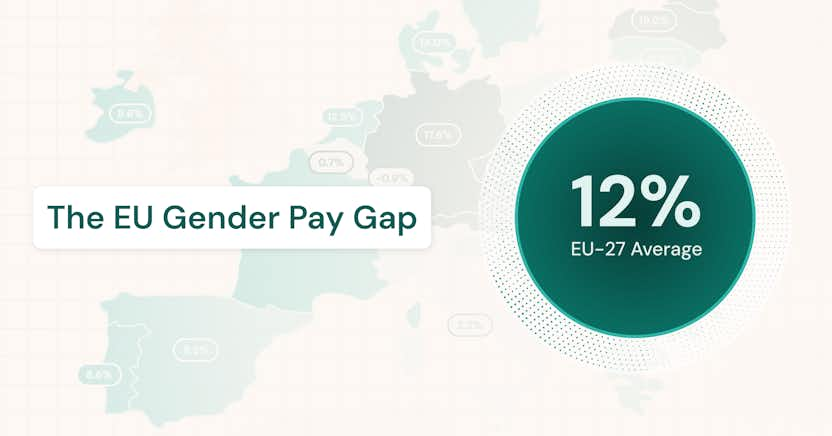Compa-Ratio: A Complete Guide to Fair and Competitive Compensation

Learn more about the following beqom products
What is a compa-ratio and why is it important?
To remain competitive in today’s job market, organizations must balance internal equity with external market trends. The compa-ratio, short for "comparison ratio," is a powerful metric that enables businesses to evaluate whether employee salaries are aligned with the market and internal salary ranges.
By comparing an employee's salary to the midpoint of their salary range, the compa-ratio sheds light on pay equity, disparities, and alignment with compensation strategies. It ensures that employees are paid fairly while helping organizations meet their budgetary and strategic goals. It also helps to identify at-risk employees who may be underpaid or spot over-payment anomalies.
Understanding compa-ratios is critical for designing effective pay structures, retaining top talent, and maintaining trust within the workforce.
Understanding the purpose of the compa-ratio
At its core, the compa-ratio helps organizations gauge how closely employee compensation aligns with pay policies and the competitive market. It enables HR professionals to benchmark salaries against the midpoint of the salary range, using either the internal or market range. This metric is central to addressing issues such as pay equity and employee satisfaction.
Benefits of using a compa-ratio in compensation strategy
Using compa-ratios in compensation strategies provides organizations with a clearer picture of their overall pay structure. Some key benefits include:
- Ensuring internal equity: By analyzing compa-ratios across employees, companies can identify pay disparities and adjust compensation where necessary.
- Market competitiveness: Organizations can align compensation with industry benchmarks to attract and retain top talent.
- Optimized decision-making: Compa-ratios help inform decisions during merit increases, promotions, or compensation planning.
- Pay equity compliance: Compa-ratios are one tool to flag pay anomalies that could reflect pay inequity. The use of pay equity software then can determine if there are true pay gaps and help ensure compliance with equal pay regulations.
How to calculate a compa-ratio: formula and examples
The calculation of a compa-ratio is straightforward, but understanding its applications and implications requires a deeper dive. By mastering the formula and applying it to real-world scenarios, businesses can use this metric to refine their compensation strategies.
Step-by-step guide to calculating compa-ratio
The compa-ratio formula is as follows:
Compa-Ratio = (Employee's Salary ÷ Salary Range Midpoint) × 100
Here’s how to calculate it step by step:
1️⃣ Gather salary data: Obtain the employee’s current salary and identify the midpoint of their assigned salary range.
2️⃣ Perform the calculation: Divide the employee’s salary by the salary range midpoint.
3️⃣ Express as a percentage: Multiply the result by 100 to convert it to a percentage.
For example:
- Employee salary: $60,000
- Salary range for the position: $50,000-$90,000
- Salary range midpoint: $70,000
- Calculation: ($60,000 ÷ $70,000) × 100 = 85.7%
This compa-ratio of 85.7% indicates that the employee is paid below the midpoint, which may warrant further analysis.
This example looks at an employee who is above the salary range midpoint:
- Employee salary: $85,000
- Salary range for the position: $50,000-$90,000
- Salary range midpoint: $70,000
- Calculation: ($85,000 ÷ $70,000) × 100 = 121.4%
This compa-ratio of 121.4% indicates that the employee is paid well above the midpoint. Again, HR or management can then look to see if there is a solid rationale for the employee being towards the high end of the range.
Real-world examples of compa-ratio calculation
To illustrate, let’s consider a scenario where a manager wants to review the compa-ratios of their team vis-a-vis the market ranges:
- Employee A earns $55,000 in a market range with a $65,000 midpoint. Their compa-ratio is 84.6%.
- Employee B earns $72,000 in the same range. Their compa-ratio is 110.8%.
These figures reveal that Employee A is underpaid relative to the market range, while Employee B is paid above the midpoint. The manager can then review the salaries vs. the employee skills, performance, tenure, etc., and determine if the employees are being paid fairly vs. the market rate.
Using compa-ratio as a percentage vs. decimal
While some HR professionals prefer decimals (e.g., 0.90), percentages (e.g., 90%) are more intuitive and practical for communicating pay data to stakeholders.
What is a good compa-ratio range?
The ideal compa-ratio range varies by industry, job level, and company goals. Generally, a range of 80%-120% is considered acceptable, but understanding why this range matters is key to using compa-ratios effectively.
The ideal compa-ratio range: 80%-120% explained
- Below 80%: Employees are being paid significantly below the range for the position. This can lead to dissatisfaction, low retention, and challenges in attracting talent.
- Between 80%-100%: Indicates that pay is below or at the range midpoint. This range is common for new hires or employees in roles with limited experience.
- Above 100%: Salaries in this range often reflect tenure, performance, or roles critical to business operations.
Factors that influence compa-ratio variations
Several factors can lead to differences in compa-ratios across an organization, including:
- Job type: Specialized roles may command higher compa-ratios due to unique skills or certifications, as compared to the market definition of the job.
- Company size: Larger organizations may have more standardized pay structures, with ratios closer to market averages.
- Economic conditions: Market fluctuations can affect salary benchmarks, influencing ratios such as when pay compression occurs.
Regular analysis using tools like compensation management software helps organizations navigate these variations effectively.
Types of compa-ratios: individual, group, and more
Compa-ratios can be analyzed at different levels to meet specific business needs. Understanding the distinctions between individual, group, and average compa-ratios provides valuable insights for decision-making.
Individual compa-ratio: a focus on employee-level analysis
An individual compa-ratio assesses an employee’s pay compared to their range’s midpoint. This analysis highlights pay disparities that may affect retention or satisfaction. For example, an individual compa-ratio of 70% signals underpayment and the need for review.
Group compa-ratio: insights for teams and departments
Group compa-ratios aggregate individual ratios for broader insights. For example, calculating the compa-ratio for a department can reveal trends, such as pay disparities or alignment with market benchmarks.
Comparing average compa-ratios across organizations
Benchmarking the average compa-ratio against industry standards can inform competitive compensation strategies. This process is essential for organizations striving to remain attractive to top talent while maintaining internal equity.
How to use compa-ratios to enhance your pay structure
By analyzing compa-ratios, organizations can make data-driven decisions to address pay gaps and improve alignment with strategic goals. These metrics also enhance transparency and trust within the workforce.
How do compa-ratios help with pay equity compliance?
Compa-ratios are an effective tool for identifying and addressing pay disparities that may affect compliance with pay equity laws. By systematically comparing employee salaries to the midpoint of their respective salary ranges, organizations can:
- Spot inequities: A pattern of low compa-ratios among certain demographic groups (e.g., gender, race, or ethnicity) can signal potential pay inequities that need to be addressed to avoid legal and reputational risks.
- Ensure consistent pay policies: Compa-ratios enable HR teams to review compensation practices and ensure they are applied fairly across all employees, reducing the risk of unintentional biases.
- Support data-driven corrections: By using pay equity software and compa-ratio analysis together, organizations can adjust salaries transparently and equitably, ensuring compliance with laws such as the Equal Pay Act and other regional regulations.
Ultimately, compa-ratios provide a clear, measurable way to align compensation with equity standards while fostering trust and fairness in the workplace.
How do compa-ratios help to align pay with organizational goals?
Compa-ratios are a strategic tool that ensures an organization’s compensation practices directly support its overall objectives. Here’s how they help:
- Facilitating budget control: Organizations aiming to manage costs can use compa-ratios to maintain salaries closer to the midpoint, ensuring financial sustainability without compromising fairness.
- Rewarding top talent: For companies focused on innovation or high performance, compa-ratios above 100% for high-performing employees can align pay with contributions, incentivizing excellence.
- Supporting equitable growth: Organizations committed to diversity and inclusion can use compa-ratios to identify and eliminate disparities, fostering a culture of equity that aligns with their values.
- Benchmarking against the market: For businesses striving to be competitive employers, compa-ratio analysis ensures salaries align with market benchmarks, helping to attract and retain top talent.
- Driving pay transparency: Transparent communication around compa-ratio policies supports organizational goals of building trust, reducing turnover, and enhancing employee satisfaction,
- Aligning with organizational goals: Organizations can tailor their compa-ratios to reflect specific objectives. For example, a startup may aim for ratios closer to 80% to control costs, while a tech firm might target 120% to attract highly skilled engineers.
By regularly analyzing and adjusting compa-ratios, organizations can align their compensation strategies with key priorities such as innovation, equity, and market competitiveness, while ensuring consistent application across the workforce.
Limitations of compa-ratios and common pitfalls to avoid
While compa-ratios are valuable, they aren’t a one-size-fits-all solution. Understanding their limitations ensures a more balanced approach to compensation management.
When compa-ratios may not provide the full picture
Compa-ratios only account for base salary and exclude bonuses, stock options, or other benefits. Tools like compensation management software can complement this analysis by offering a holistic view of employee compensation. Other types of people analytics may also help to give a more rounded view of the workforce.
Addressing outliers in compa-ratio calculations
Outliers, such as unusually low or high compa-ratios, can distort overall insights. These should be examined carefully to determine if adjustments are necessary or if they reflect valid exceptions, such as extraordinary performance.
FAQ: Understanding the compa-ratio
What is a compa-ratio?
A compa-ratio is a metric that compares an employee’s salary to the midpoint of their salary range, expressed as a percentage or decimal. The range may be based on a company’s internal salary ranges per role, or on market-based ranges from benchmark data.
What does a compa-ratio of 0.75 mean?
It means the employee is earning 75% of the salary range midpoint, indicating they may be underpaid, but also may simply be new or at a lower skill level within the range.
What does an 80% compa-ratio mean?
An 80% compa-ratio signals that the employee earns 80% of the salary midpoint, often suggesting room for pay increases.
What should be the ideal compa-ratio?
The ideal compa-ratio typically falls between 80%-120%, depending on market trends and company strategy.
Is it bad if an employee has a high or low compa-ratio?
Not necessarily. A high or low compa-ratio can indicate different scenarios that aren’t inherently “bad,” but they should prompt further investigation:
- Low compa-ratio (below 80%): This typically means the employee is earning below the salary range midpoint. While it might signal underpayment, it could also reflect a newer employee who is still developing skills or gaining experience for the role. However, if low compa-ratios are widespread or persist for long-tenured employees, it may indicate pay inequities or market misalignment.
- High compa-ratio (above 120%): This suggests the employee is earning significantly above the midpoint, which might be justified for high performers, employees with extensive tenure, or roles critical to business success. However, if too many employees have high compa-ratios, it could indicate salary inflation or lack of budgetary control.
The key is to understand the context behind high or low compa-ratios and address any discrepancies in alignment with organizational goals and pay equity standards.
beqom’s compensation management software streamlines the process of calculating, analyzing, and optimizing compa-ratios Paired with tools like pay equity software and pay intelligence, beqom empowers organizations to create fair and competitive compensation structures.
Ready to enhance your compensation strategy? Contact beqom today.







